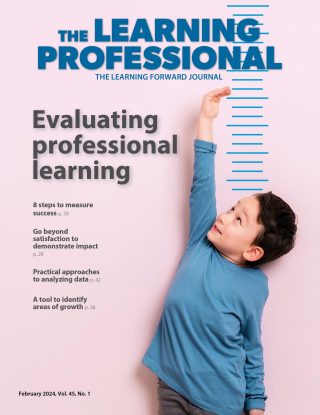FOCUS
Steps to self-reliance
Coaching process strengthens math students' confidence
By Sue Chapman and Mary Mitchell
Categories: Coaching, Data, ImplementationDecember 2019
Vol. 40, No. 6
Read the remaining content with membership access. Join or log in below to continue.
Sed ut perspiciatis unde omnis iste natus error sit voluptatem accusantium doloremque laudantium, totam rem aperiam, eaque ipsa quae ab illo inventore veritatis et quasi architecto beatae vitae dicta sunt explicabo. Nemo enim ipsam voluptatem quia voluptas sit aspernatur aut odit aut fugit, sed quia consequuntur magni dolores eos qui ratione voluptatem sequi nesciunt. Neque porro quisquam est, qui dolorem ipsum quia dolor sit amet, consectetur, adipisci velit, sed quia non numquam eius modi tempora incidunt ut labore et dolore magnam aliquam quaerat voluptatem.
References
Black, P. & Wiliam, D. (2010, September). Inside the black box: Raising standards through classroom assessment. Phi Delta Kappan, 92(1), 81-90.
Hattie, J. (2012). Visible learning for teachers: Maximizing impact on learning. Thousand Oaks, CA: Corwin.
Huinker, D. & Bill, V. (2017). Taking action: Implementing effective mathematics teaching practices. Reston, VA: National Council of Teachers of Mathematics.
Killion, J. (2008). Assessing impact: Evaluating staff development. Thousand Oaks, CA: Corwin.
National Council of Teachers of Mathematics. (2014). Principles to actions: Ensuring mathematical success for all. Reston, VA: Author.

Sue Chapman (chapmans@uhcl.edu) is an adjunct instructor at the University of Houston-Clear Lake and a professional learning consultant at Math Solutions.
Mary Mitchell (mmitchell@mathsolutions.org) is a lead instructional designer at Math Solutions.
Categories: Coaching, Data, Implementation
Recent Issues
TAKING THE NEXT STEP
December 2023
Professional learning can open up new roles and challenges and help...
REACHING ALL LEARNERS
October 2023
Both special education and general education teachers need support to help...
THE TIME DILEMMA
August 2023
Prioritizing professional learning time is an investment in educators and...
ACCELERATING LEARNING
June 2023
Acceleration aims to ensure all students overcome learning gaps to do...











